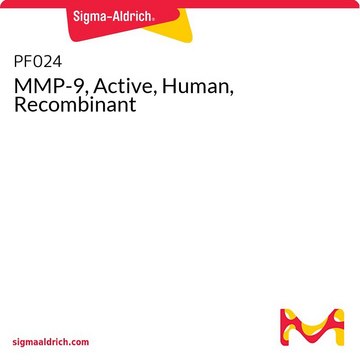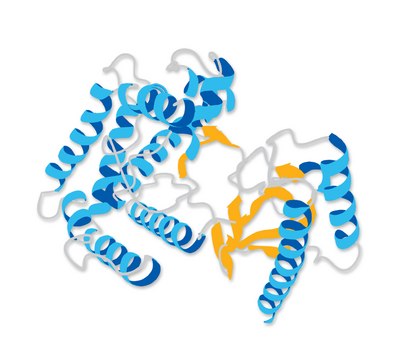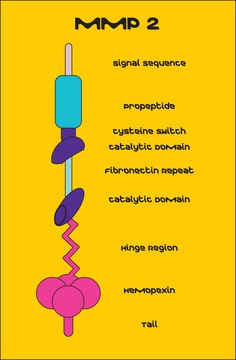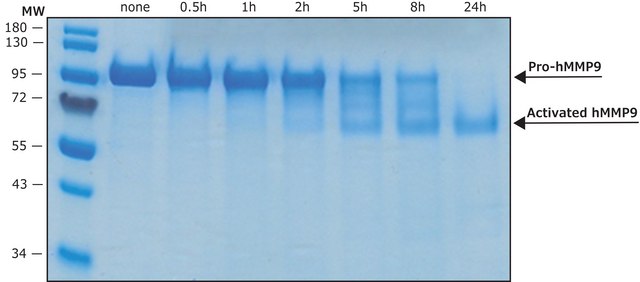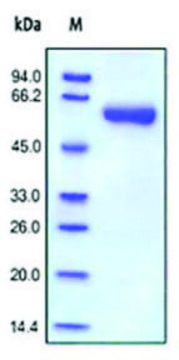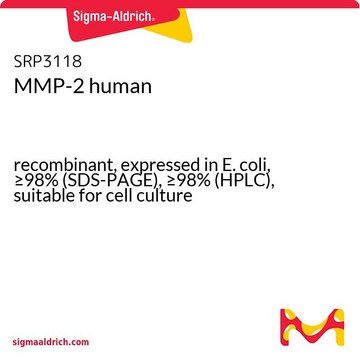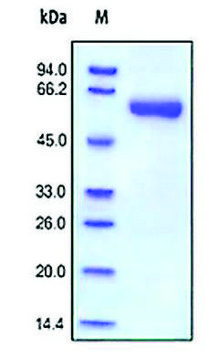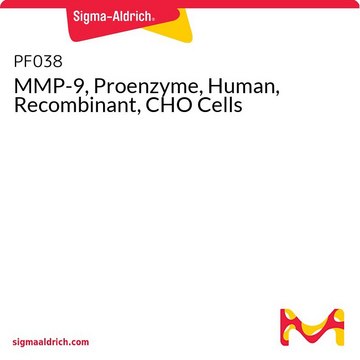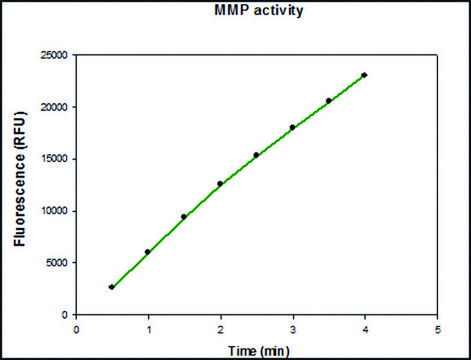SAE0078
MMP-9 pre-activated human
recombinant, ≥1,300 pmol/min/μg, expressed in HEK 293 cells
Synonym(s):
GELB, GELBCLG4B, Gelatinase, Gelatinase B, MANDP2, MMP-9, Matrix Metalloproteinase-10, Type IV collagenase
Select a Size
About This Item
Recommended Products
biological source
human
Quality Level
recombinant
expressed in HEK 293 cells
Assay
≥95% (SDS-PAGE)
form
liquid
mol wt
calculated mol wt 66 kDa
observed mol wt 82 kDa by SDS-PAGE (The protein migrates as a 82 kDa protein on SDS-PAGE due to glycosylation)
concentration
≥50 μg/mL
UniProt accession no.
application(s)
cell analysis
shipped in
dry ice
1 of 4
This Item | M8945 | SAE0075 | SAE0077 |
|---|---|---|---|
| recombinant expressed in HEK 293 cells | recombinant - | recombinant expressed in HEK 293 cells | recombinant expressed in HEK 293 cells |
| biological source human | biological source - | biological source - | biological source human |
| concentration ≥50 μg/mL | concentration - | concentration - | concentration 50-200 μg/mL |
| mol wt calculated mol wt 66 kDa, observed mol wt 82 kDa by SDS-PAGE (The protein migrates as a 82 kDa protein on SDS-PAGE due to glycosylation) | mol wt apparent mol wt ~93 kDa | mol wt calculated mol wt 138 kDa (The protein migrates as a 180 kDa protein on SDS-PAGE due to glycosylation) | mol wt calculated mol wt 76 kDa, observed mol wt 92 kDa (The protein migrates as a 92 kDa protein on SDS-PAGE due to glycosylation) |
| form liquid | form buffered aqueous solution | form lyophilized powder | form liquid |
General description
Biochem/physiol Actions
As with most MMPs, MMP-9 is secreted as an inactive pro-protein which is activated when cleaved by extracellular proteinases. MMP-9 can be cleaved (and thus activated) in vitro using 4-Aminophenylmercuric acetate (APMA), Cat. No. A9563. MMP-9 is secreted from neutrophils, macrophages, and a number of transformed cells, and is the most complex family member in terms of domain structure and regulation of its activity.
Structurally, MMP9 maybe be divided into five distinct domains: a pro-domain which is cleaved upon activation, a gelatin binding domain consisting of three contiguous fibronectin type II units, a catalytic domain containing the zinc binding site, a proline rich linker region, and a carboxyl terminal hemopexin like domain.
As with most MMPs, MMP-9 is secreted as an inactive pro-protein which is activated when cleaved by extracellular proteinases. This product was cleaved and activated in vitro using 4-Aminophenylmercuric acetate (APMA), Cat. No. A9563.
Other Notes
Physical form
Storage Class Code
12 - Non Combustible Liquids
WGK
WGK 3
Flash Point(F)
Not applicable
Flash Point(C)
Not applicable
Regulatory Information
Choose from one of the most recent versions:
Certificates of Analysis (COA)
Don't see the Right Version?
If you require a particular version, you can look up a specific certificate by the Lot or Batch number.
Already Own This Product?
Find documentation for the products that you have recently purchased in the Document Library.
Our team of scientists has experience in all areas of research including Life Science, Material Science, Chemical Synthesis, Chromatography, Analytical and many others.
Contact Technical Service